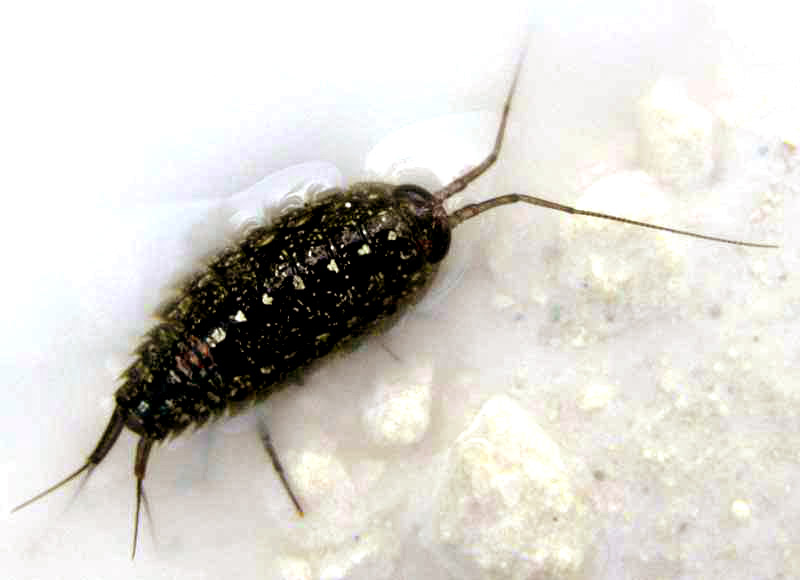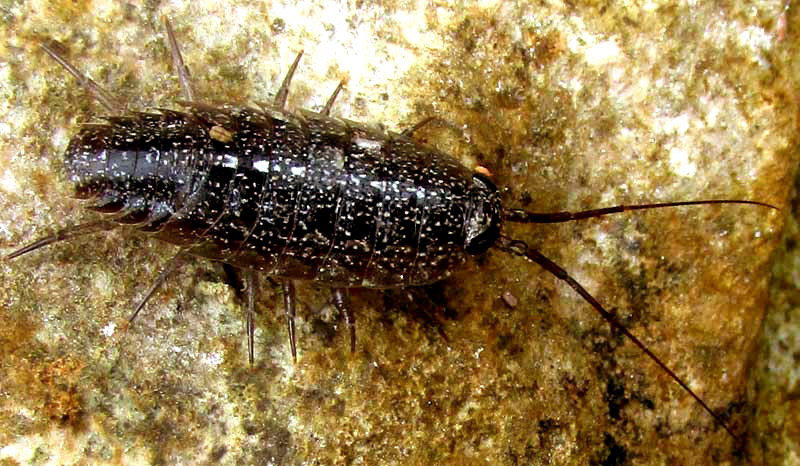Excerpts from Jim Conrad's
Naturalist Newsletter

from the July 17, 2011 Newsletter issued from Mayan Beach Garden Inn 20 kms north of Mahahual; Caribbean coastal beach and mangroves, ~N18.89°, ~W87.64°, Quintana Roo state, MÉXICO
SCURRYING ROCK LICE IN A ROAD PUDDLE
Not long after dawn and a night of intermittent showers I biked the white-sand beach road where it tunnels through scrub next to the mangrove just to our north. While zigzagging around the road's many puddles, suddenly about a dozen dark, inch-long (2.5cm) critters began scurrying below me, spooked by the bike. They reminded me exactly of how cockroaches skitter about when suddenly the lights are turned on in a messy kitchen.
But, these cockroach-like beings had seemed to be gathered at the pools' margins where there was nothing to eat, just white sand meeting chalky-colored water. I went back and photographed the individual shown above.
Up closer I could see that, with such a many-segmented body, it wasn't an insect but rather an isopod -- a member of the crustacean order Isopoda, like sowbugs, pillbugs, millipedes and centipedes. But this was like no isopod I'd ever seen.
In the picture you can see that the creature's legs, an antenna and its rear appendages (uropods) were under water; I thought that maybe he'd drowned. I started to nudge him but before my finger got close suddenly he raced off as fast as a guilty cockroach. No, this animal was doing what he wanted to do, which was to hang out half submerged in water.
By day's end, volunteer identifier Bea in Ontario had pointed me toward an isopod family I'd never heard of, the Ligiidae, the Woodlice Family. Building on that insight, now I've about convinced myself that what we have here is a Rock Louse, genus Ligia, maybe LIGIA OCCIDENTALIS, known to occur from southern California into Central America.
Rock Lice are regarded as intertidal species -- living among rocks between upper and lower tides -- and are known to be mostly nocturnal. They are scavengers, often feeding on microscopic algae. One source describes them as being nearly terrestrial, despite their having gills. These gills serve them well in the intertidal zone, but restrict their land-roamings to wet areas where they can keep their gills moist.
Therefore, I'm guessing that these Rock Lice, during a night of frequent showers, strayed a little too far from the beach and at dawn were caught where the only water they had to keep their gills moist were puddles in the sand road. With occasional vehicles coming down the road, it was a vulnerable position to be in.
Rock Louse! What a pleasure to meet something so different from anything else you've always known!
from the July 12, 2015 Newsletter issued from Río Lagartos, on the Yucatan Peninsula's northern coast (~N21.60°, ~W88.16°), Yucatán state, MÉXICO
ROCK LICE IN A MANGROVE POND
On the mangrove side of a culvert beneath the Malecón extending from Río Lagartos to the tourist establishment of Chiquilá east of town, there's a little pond whose banks they've stabilized by dumping large rocks at the water's edge. Algae now cover the rocks and so many crabs and other critters hide among them that when you approach the rocks there's a frenzy of scampering as things rush to shelter. One of those scamperers, with a body length minus antennae of about half an inch long (13mm) -- and there are multitudes of them -- is shown below:

That looks a lot like a pillbug or sowbug, though I haven't seen any roll into a pill. Its segmentation, seven pairs of legs, and other features make it, like pillbugs and sowbugs, an isopod, meaning that it belongs to the Order Isopoda of the Subphylum Crustacea (crustaceans) of the Phylum Arthropoda (arthropods).
We've run into something like this before {top of page}, also intimately associated with water, down on the Caribbean coast north of Mahahual, where we found very similar individuals, though those were larger and bore conspicuous, antenna-like items projecting from their rear ends (uropods).
Back then we learned that critters looking and behaving like this are rock lice, of the isopod genus Ligia. Our rock-pile species bears speckles and spots almost identical to those we saw on the coast, despite its apparently being a different species.
Whatever kind of rock louse we have here, whenever I visit that little pond I look forward to seeing them skittering among the rocks.